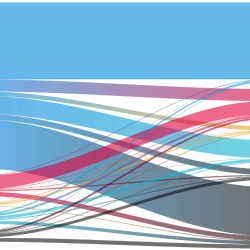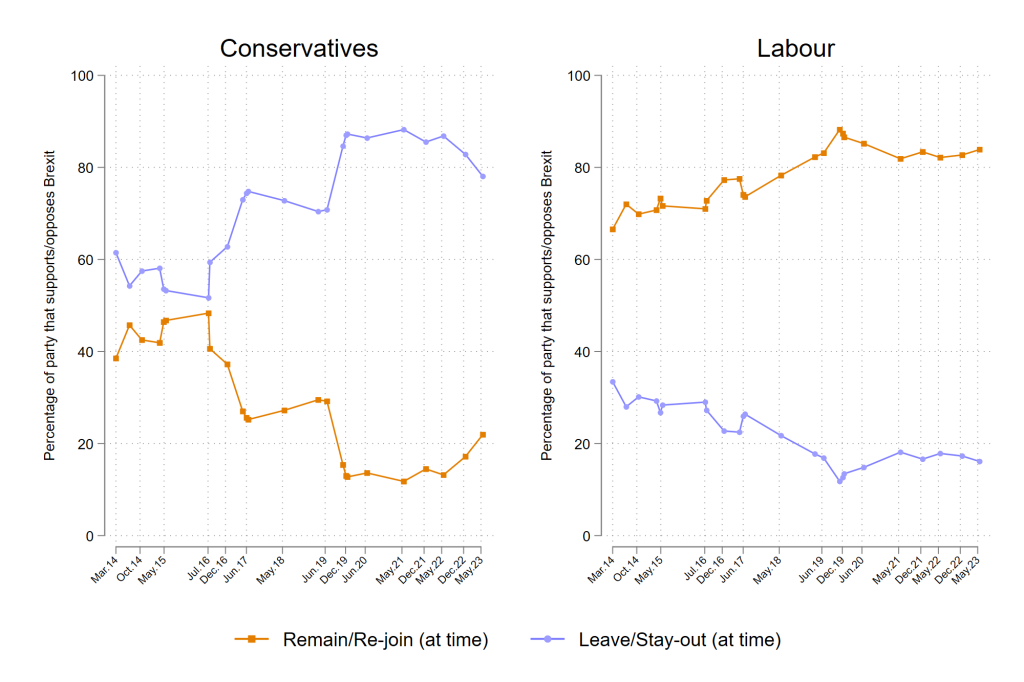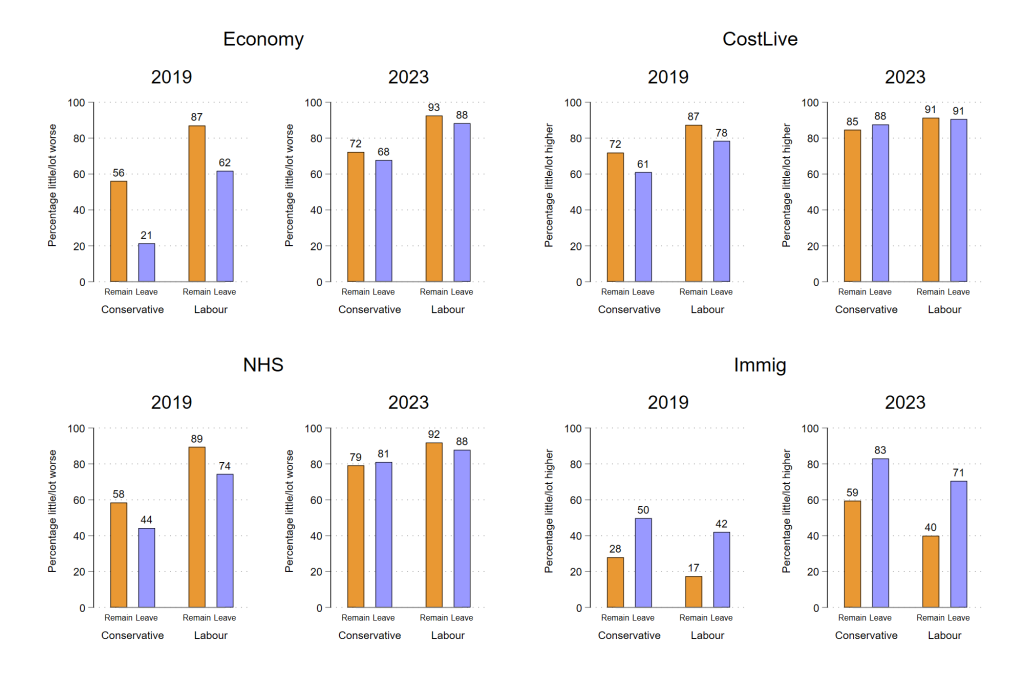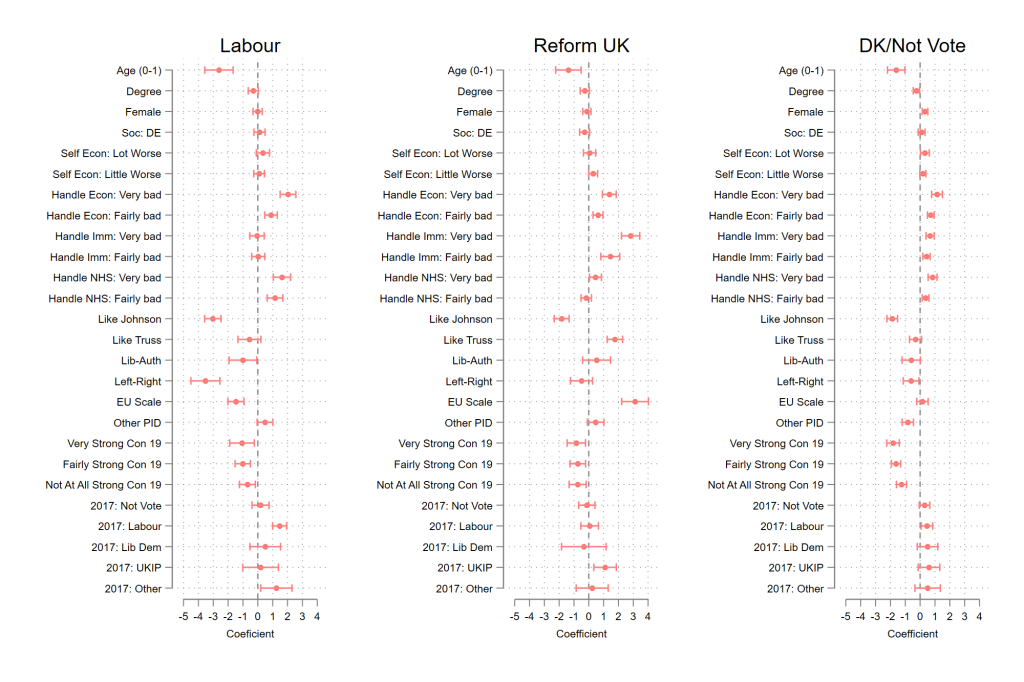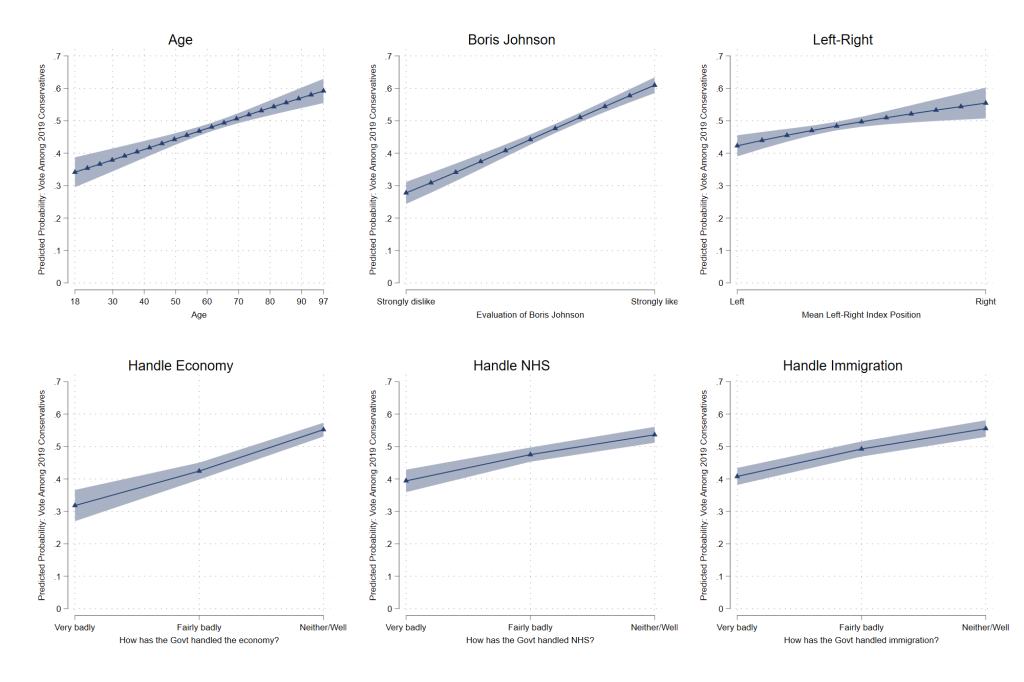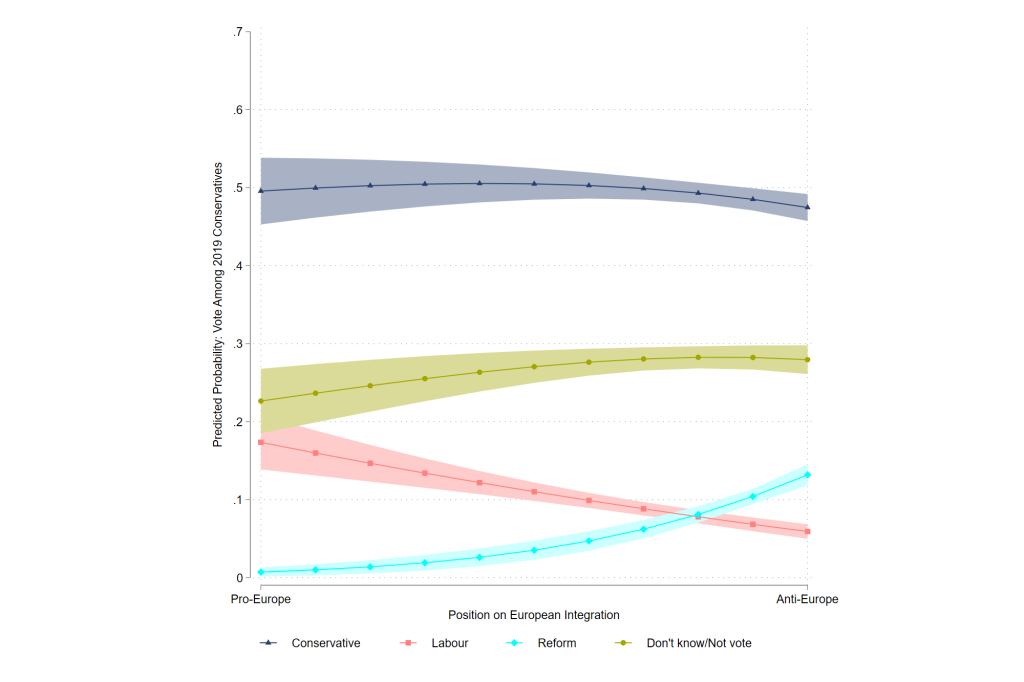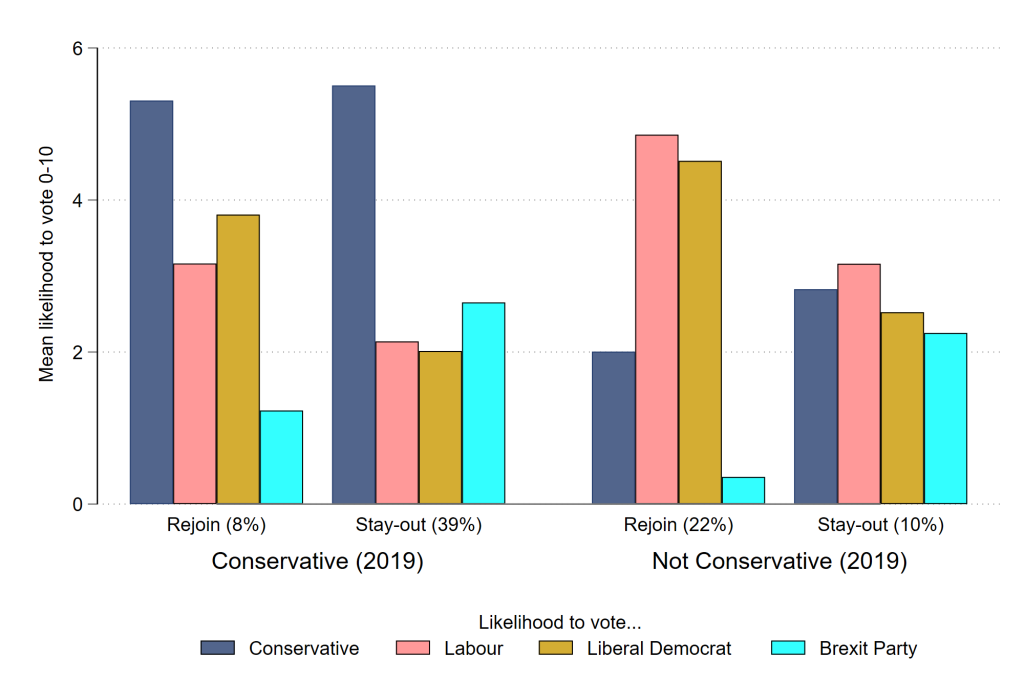James David Griffiths, Ed Fieldhouse, Jane Green, Geoffrey Evans, and Dan Snow
Brexit still shapes political support, despite the collapse in Conservative vote. Recent electoral shocks are splitting the Tories on the pro- and anti-Europe wings of the party, although there was a large group of undecided voters that leaned towards the Conservatives in May 2023.
The 2016 EU referendum shook British politics. Long-term trends, like Labour’s gradual decline in working-class areas, were accelerated in the wake of the vote. While voters increasingly sorted themselves along Brexit lines, the Conservatives’ monopolisation of Leave voters helped them to deliver a parliamentary majority in 2019 that changed the electoral map of England and Wales.
However, the political picture has now changed. Voters place far less emphasis on Europe, and the Conservatives find themselves languishing behind Labour in the polls following the government’s handling of the pandemic, party-gate, the 2022 mini-budget, and a persistent cost-of-living crisis. These developments raise questions about the legacy of Brexit; specifically – does Brexit continue to structure British politics?
Data from the recently released 25th wave of the British Election Study internet panel indicates that it does, but the Conservatives’ losses have weakened their dominance among Leavers. In general, defectors are younger, much less supportive of Boris Johnson, and are critical of the UK Government’s handling of the economy. Around a quarter of 2019 Tories have switched to another party – mostly one that is consistent with their current position on Europe (those who have switched to Labour are now more supportive of ‘Rejoin’ in a second referendum, while those who have switched to Reform tend to be strongly opposed to Europe). However, most defectors are now undecided (non-voting/don’t know) – and most undecided voters support Brexit – so the Tories may be able to reclaim some of their lost Leave vote.
The persistence of the Brexit cleavage
Understanding the legacy of Brexit requires investigating changes in voting behaviour among Leave/Remain voters since 2019, and doing so illustrates that Brexit continues to separate voters in Britain (Figure 1). In 2023, those that supported Leave in 2019 are still more likely to vote for the Conservatives than any other political party, whereas 2019 Remainers are still more likely to support Labour.
That said, the Conservatives have certainly lost support – but they have lost it at the same rate among Leavers and Remainers. Fewer than half of Leavers that voted for the Conservatives in 2019 say that they will support the party in the next election, with a similar proportion of defections present among Remainers. However, the Tories’ dominance among Leavers means that these losses have had a bigger impact on the party’s overall vote share.
Most defectors from the Tories are now without a party, as around 30 percent of 2019 Tory voters (from both Brexit camps) now say that they either don’t know who they will vote for in the next election or that they will not vote. Around a quarter 2019 Tory voters have switched to another party, with the biggest beneficiaries among Leavers being Reform UK (11 percent of Leave supporting 2019 Tory voters) and Labour (7 percent).
A similar proportion of Remain voters have also switched, with 12 percent of 2019 Tory voting Remainers now saying that they will vote for Labour (and 7 percent Liberal Democrat) – but again these losses will be felt less sharply because Remainers represented a smaller proportion of the Conservatives’ electorate.
Figure 1: Change in vote share between 2019 and May 2023 among those who said that they would vote Leave/Remain in a second referendum after the 2019 General Election.
Source: British Election Study Internet Panel Wave 25 (N: 6,622 [Leave]; 6,155 [Remain]). Weighted for those present in both 2019 (wave 19) and 2023 (wave 25).
Note: Percentages denote the percentage of voters for each party that have the same Brexit position in 2023 as they did in 2019 (i.e., 61% of Leavers that switched to Labour have stayed Leavers. The other 39% have either switched to Re-join, would not vote, or don’t know).
Due to these similar rates of defection, support for Brexit among Conservative and Labour voters is close to what it was in 2019 (Figure 2). While there has been a slight decline in the proportion of Conservative voters that support Brexit since May 2022, their voters are still overwhelmingly pro-Brexit. In contrast, Labour voters continue to be predominantly anti-Brexit, with the party picking up more Remainers from the Liberal Democrats than it has Leavers from the Conservatives. Moreover, many of the 2019 Leavers that switched from the Conservatives to Labour have lost their support for Brexit (see Figure 1), whereas a similar proportion of those 2019 Remainers who stayed Conservatives have lost their opposition – serving to bolster the Conservative/Leave and Labour/Remain connections. As a result, the Brexit-based sorting persists among the electorates of the two major parties.
Figure 2: Percentage of Conservative and Labour voters that support/oppose Brexit over time.
Source: British Election Study Internet Panel
Conservatives facing competency shocks.
The Conservatives may be facing losses on both sides of the Brexit cleavage because Leave and Remain voters are now similarly unhappy about the issues that matter to them most; namely the economy and health (Figure 3). In this context, the UK Government may no longer be able to rely on a post-referendum ‘Brexit advantage,’ where Leavers were less negative than Remainers about the state of the NHS, economy, and cost-of-living – with assessments now being relatively similar between the two camps once we take partisanship into account. There is still a Brexit-gap for immigration (another important issue), but this may also hurt the Tories among Brexit supporters because net migration is rising.
Figure 3: Assessments of the performance of the NHS, economy, immigration, and cost of living among 2019 Brexit camps in 2019 and 2023 by vote in the 2019 General Election.
Source: British Election Study Internet Panel. Questions: “Do you think that each of the following are getting better/lower, getting worse/higher or staying about the same?” Lot or little lower/worse, staying the same, lot or little higher/better.
Investigating defection from the Conservatives
To explore how the recent crises have affected the Conservatives, we ran a multinomial logistic regression model for vote intention among 2019 Conservatives (Figure 4). Overall, we find that defection (i.e., 2019 Tories not voting Tory now) associates heavily with three characteristics – age, criticism of the UK Government’s handling of the economy, and dislike of Boris Johnson (Figure 5). Those who are more economically left-wing and critical of the UK Government’s handling of immigration are also less likely to vote Conservative again now, but the effects for these items are weaker relatively. Furthermore, Brexit support does not associate with defection per se, but those that switch to another party do so in different directions in line with their attitudes towards Europe.
Figure 4: Logit coefficient plots for multinomial logistic regression model for vote intention in May 2023 among 2019 Conservative voters.
Source: British Election Study Internet Panel Wave 25 (N: 4,308, Pseudo R2: 0.27). Analysis limited to those that voted for the Conservatives in 2019. Dependent variable: Currently would vote for the Conservative (ref.), Labour, Reform UK, don’t know and would not vote, and other parties (included in the model, but not displayed for brevity).
The defection of younger voters may reflect the pre-existing issues that the Conservatives have in this area, as some Tories are aware that their housing and environmental policies may make them unpopular among younger voters. However, the loss of support among those critical of both the UK Government’s handling of the economy and Boris Johnson suggests that the Conservatives are also struggling to deal with the recent shocks facing the party – namely, party-gate (which forced Boris Johnson to resign) and the cost-of-living crisis. Surprisingly, household economic circumstances have no effect on defection to any destination (see Figure 4), so voters may not be holding the Government directly responsible for changes in their personal finances, but they do certainly appear to be punishing them for their perceived handling of the economy overall.
Figure 5: Predicted probability of voting for the Conservatives in May 2023 among those that voted for the Conservatives in 2019 by age, competency evaluations, left-right ideology, and evaluations of Boris Johnson.
Source: British Election Study Internet Panel Wave 25 (N: 4,308). Results for other parties are not displayed here to focus specifically on defection from the Conservatives.
While defectors may have some similarities, our results indicate that the Conservatives are losing support on both ‘wings’ of their party. Overall, around 8% of their 2019 vote had gone to Labour by May 2023, and around 9% to Reform UK. The clearest indicator here is support for Europe (Figure 6). Leave and Remainers may be defecting at a similar rate, but those who do defect and are more supportive of Europe are more likely to switch to Labour. In contrast, those who defect and are more opposed to Europe are more inclined to switch to Reform.
Those splintering from the Tories on either side of the party also appear to have different priorities. Being economically left-wing and critical of the UK Government’s handling of the NHS associates with switching to Labour, whereas being pro-Truss and critical of the UK Government’s handling of immigration associates with switching to Reform (see Figure 4). Yet, despite their different priorities, it is important to emphasise that defectors from the Conservatives share a belief that the current UK Government has handled the issues that matter to them poorly.
Figure 6: Predicted probability of intending to vote for a party at the next general election among those that voted for the Conservatives in 2019 by preferences for European policy.
Source: British Election Study Internet Panel Wave 25 (N: 4,308).
What about those without a party?
However, it is important to reiterate now that – even if they are losing support on both wings of the party – the Tories’ biggest losses were to non-voting/don’t know (as of May 2023). Policy/attitudinal positions have far less of an effect on the non-voting/don’t know group, which suggests that these individuals (who are slightly more likely to be female) are put-off by the Government’s performance rather than any specific policy direction.
Given the size of the non-voting/don’t know group, their votes will be important for the result of the next election. Overall, those who voted Tory in 2019 still lean towards them now (Figure 7). Most of their former voters support Brexit (nearly 40 percent of the entire non-voting/don’t know group), and convincing these individuals to return will be crucial if the Conservatives want to replicate Labour’s experience of attracting uncertain voters in 2017. However, the Conservatives may have less luck among those who did not vote for them previously, as these individuals are still unlikely to vote for them now.
Figure 7: Propensity to vote for political parties among those who are non-voters/don’t know by current Brexit position and vote in 2019.
Source: British Election Study Internet Panel Wave 25 (N: 3,012). Percentages indicate the proportion of all don’t know/non-voters represented by that group.
Brexit and the next election
Overall, Brexit still structures political support in Britain; as Conservative voters still tend to support Leave and Labour voters still tend to support Remain. However, Brexit is not preventing the Conservatives from being punished for perceived poor performance across the electorate. Recent defections are exacerbating the Tories’ pre-existing problems among younger voters, and the splitting of the party on its pro- and anti-Europe wings may make it difficult to design policy that is attractive to all defectors. The Conservatives seem divided internally on precisely this issue, with some supporting measures to “fight the election on the centre ground,” and others calling for stronger immigration policy and tax cuts to fight off Reform. Walking this tightrope will be difficult, especially given the negative perceptions of the Conservatives’ performance in government among both switchers and the undecided. Ultimately, the last four years have been years in which the electorate has judged the Conservatives primarily on their competence. This, then, is what they need to improve, if they are to avert electoral disaster in the next general election.

